Skyborne imagery is revolutionizing urban pedestrian design in seven key ways. You'll see improved mapping of pedestrian flow patterns, better identification of sidewalk congestion points, and optimized crosswalk placement. It's also enhancing green space integration, analyzing street furniture effectiveness, and evaluating accessibility for mobility-impaired individuals. Finally, it's helping to enhance public transit connections. These aerial perspectives provide urban planners with invaluable data to create more walkable, efficient, and enjoyable city spaces. By leveraging this technology, cities can transform their pedestrian infrastructure, leading to safer, more accessible, and vibrant urban environments. Discover how these innovations are reshaping the future of urban mobility.
Mapping Pedestrian Flow Patterns
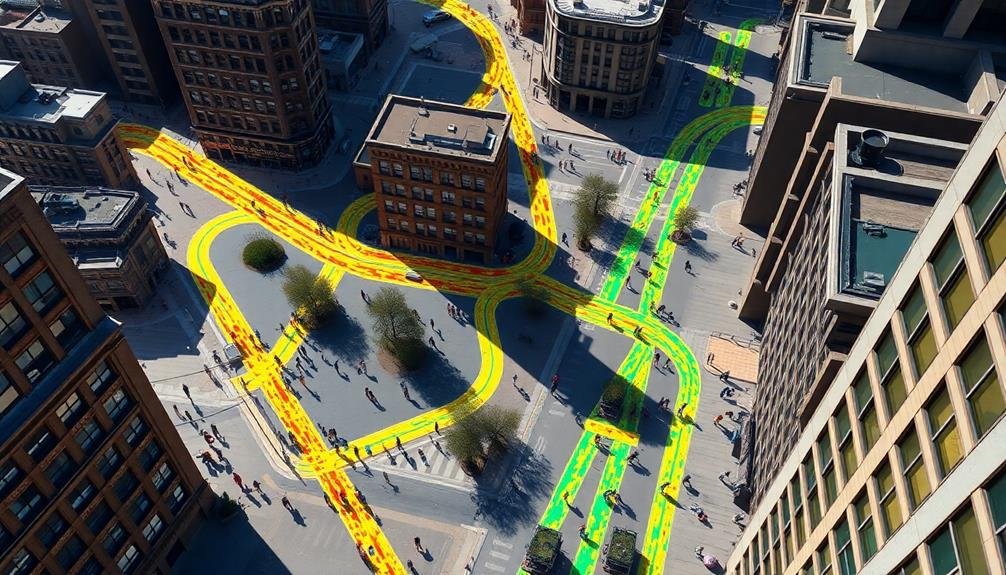
Mapping pedestrian flow patterns is an essential step in urban design and traffic management. With skyborne imagery, you'll gain unprecedented insights into how people move through urban spaces. High-resolution aerial photos and videos capture real-time movement, allowing you to analyze foot traffic across entire neighborhoods or cities.
You can identify popular routes, pinpoint congestion areas, and spot underutilized paths. This data helps you make informed decisions about sidewalk widths, crosswalk placements, and public space allocations. By overlaying heat maps onto city grids, you'll visualize pedestrian density at different times of day, revealing peak hours and quiet periods.
Skyborne imagery also lets you track seasonal changes in foot traffic. You'll notice how weather, events, or construction impact movement patterns. This information is critical for planning temporary infrastructure or adapting spaces for different uses throughout the year.
With advanced image processing, you can even differentiate between pedestrians, cyclists, and other modes of transportation. This granular data helps you design multi-use paths and optimize traffic flow for all users, creating safer, more efficient urban environments.
Identifying Sidewalk Congestion Points
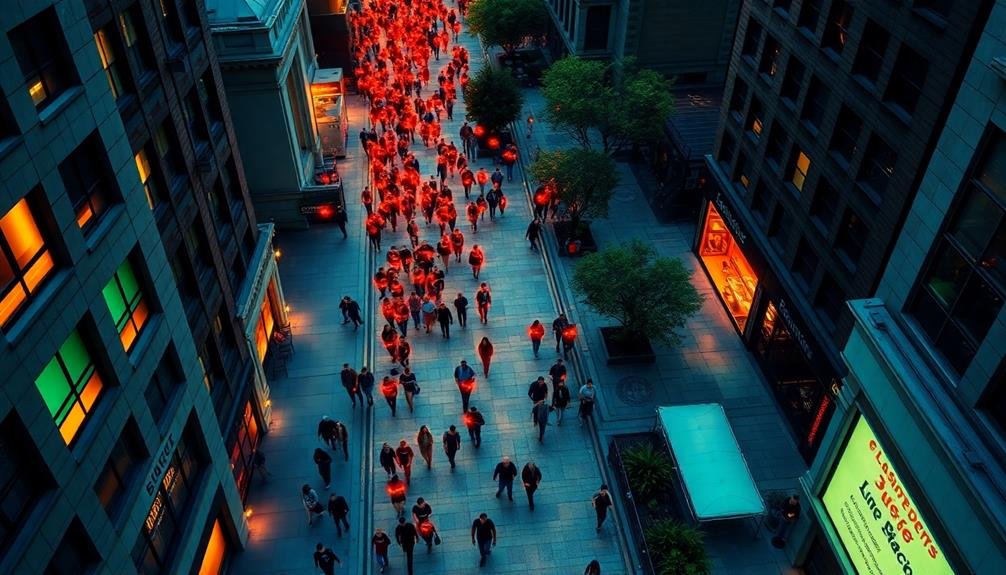
You'll find that real-time crowd flow analysis is essential for identifying sidewalk congestion points.
By leveraging advanced imaging technology, you can pinpoint bottleneck areas where pedestrian traffic tends to accumulate.
This information allows you to make informed decisions about urban design improvements, potentially alleviating congestion and enhancing the overall pedestrian experience.
Real-Time Crowd Flow Analysis
When it comes to urban planning, real-time crowd flow analysis is a game-changer. By utilizing skyborne imagery, you're able to monitor pedestrian movement patterns as they unfold. This technology allows you to identify bottlenecks, assess the effectiveness of current infrastructure, and make data-driven decisions to improve urban walkability.
With real-time analysis, you can:
| Benefits | Applications |
|---|---|
| Rapid response | Event management |
| Predictive modeling | Traffic light optimization |
| Safety enhancement | Emergency planning |
You'll find that this approach offers unprecedented insights into pedestrian behavior. By tracking crowd density and movement speed, you can pinpoint areas that require immediate attention. This data helps you design more efficient walkways, strategically place crosswalks, and optimize signal timing at intersections.
Moreover, real-time analysis enables you to adapt to changing conditions quickly. Whether it's a sudden influx of tourists or an unexpected road closure, you can adjust your urban design strategies on the fly. This flexibility guarantees that your city remains pedestrian-friendly even in the face of unforeseen challenges.
Pinpointing Bottleneck Areas
Leveraging skyborne imagery, urban planners can now pinpoint bottleneck areas with unprecedented accuracy. You'll find that aerial views provide an extensive perspective of pedestrian movement patterns, allowing for the identification of congestion hotspots that might be overlooked from ground level.
With high-resolution images and video feeds, you can observe how pedestrians navigate through urban spaces, spotting areas where foot traffic slows or comes to a standstill. These bottlenecks often occur at intersections, near popular attractions, or in poorly designed walkways.
By analyzing this data, you'll be able to identify specific locations that require immediate attention. You can use this information to implement targeted solutions, such as widening sidewalks, adding pedestrian bridges, or redesigning street layouts.
The ability to pinpoint these problem areas means you'll allocate resources more efficiently, focusing on the spots that will have the most significant impact on pedestrian flow.
Moreover, you'll be able to track the effectiveness of your interventions over time. By comparing before-and-after imagery, you can assess whether your design changes have successfully alleviated congestion and improved overall pedestrian experience in the identified bottleneck areas.
Optimizing Crosswalk Placement

Although skyborne imagery provides a bird's-eye view of urban landscapes, optimizing crosswalk placement requires a ground-level understanding of pedestrian behavior and traffic patterns.
You'll need to combine aerial data with on-site observations to identify the most effective locations for crosswalks.
Start by analyzing aerial imagery to spot desire lines—unofficial paths worn into grass or dirt—which indicate where pedestrians naturally want to cross.
You'll also want to examine traffic flow patterns and vehicle speeds from above. This data helps you pinpoint potential conflict points between pedestrians and vehicles.
Next, use street-level imagery and on-site surveys to assess visibility, sidewalk conditions, and existing infrastructure.
You'll need to take into account factors like curb cuts, traffic signals, and nearby destinations that attract foot traffic.
Assessing Green Space Integration
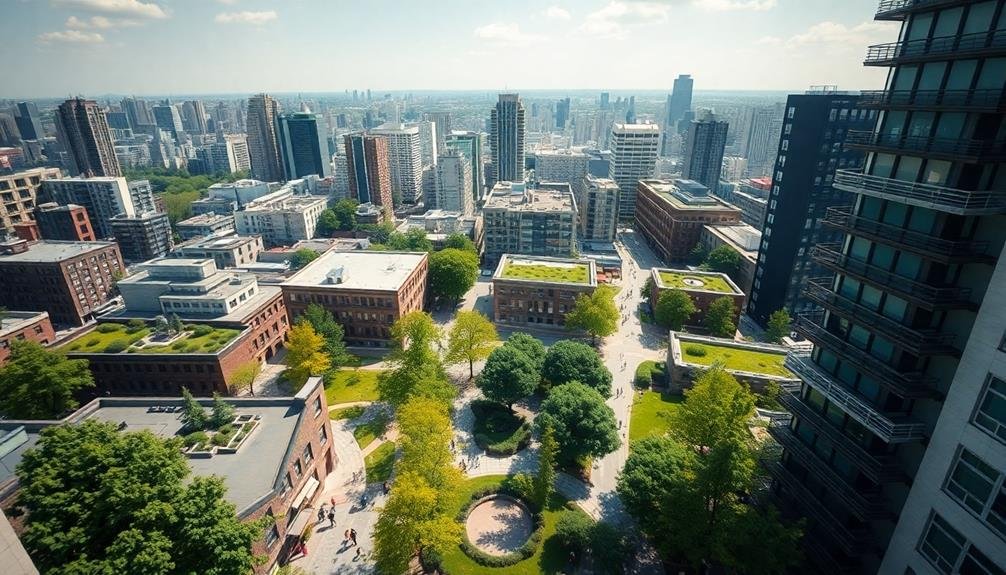
In light of urban development pressures, evaluating green space integration through skyborne imagery has become essential for pedestrian-friendly design.
You'll find that aerial and satellite imagery provides a thorough view of existing green spaces and potential areas for expansion. This bird's-eye perspective allows you to identify gaps in green corridors and assess the connectivity between parks, gardens, and other natural areas.
By analyzing these images, you can determine how well green spaces are distributed throughout the urban landscape. You'll be able to spot opportunities for creating new pocket parks, urban forests, or green roofs that enhance pedestrian experiences.
Skyborne imagery also helps you evaluate the proximity of green spaces to residential areas, ensuring equitable access for all citizens.
Moreover, you can use this technology to monitor the health and density of vegetation, identifying areas that need attention or replanting. It's an invaluable tool for tracking the progress of greening initiatives over time.
Analyzing Street Furniture Effectiveness
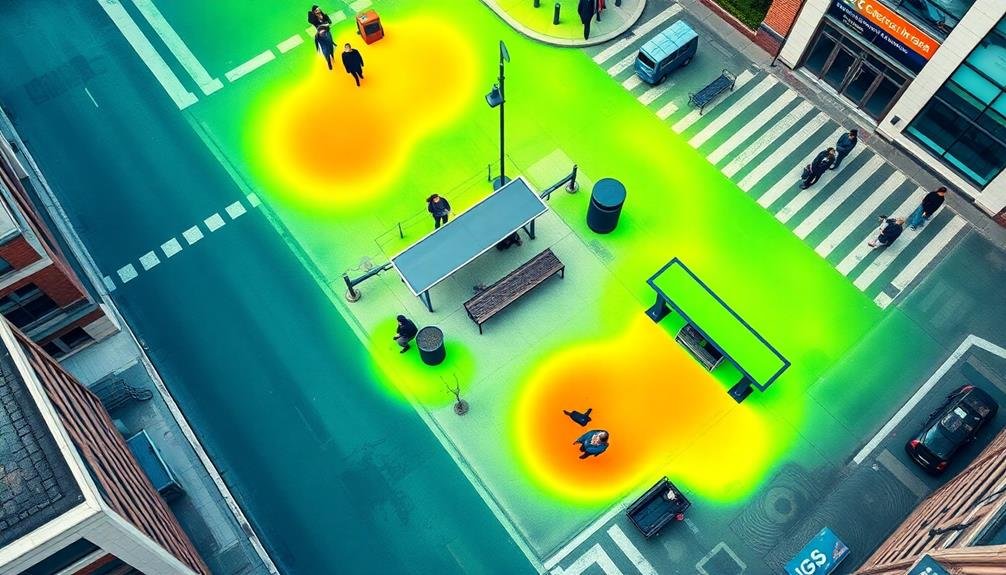
You'll find that aerial imagery can revolutionize your approach to street furniture placement.
By analyzing overhead views, you can optimize seating locations for maximum pedestrian comfort and flow.
Additionally, you'll be able to assess the effectiveness of safety features like bollards and barriers from a thorough perspective, ensuring they're strategically positioned for both protection and accessibility.
Seating Placement Optimization
Numerous factors influence the effectiveness of street furniture, particularly seating placement in urban environments. By leveraging skyborne imagery, you can optimize seating locations to maximize their use and improve pedestrian experiences.
Aerial imagery allows you to analyze foot traffic patterns, sunlight exposure, and proximity to key amenities. You'll be able to identify high-traffic areas where seating is most needed, such as near public transit stops or popular attractions.
Satellite imagery can reveal shaded spots that offer comfort during hot days, while thermal imaging helps you avoid areas prone to heat islands. By examining the surrounding context, you can place seating to take advantage of scenic views or create social spaces.
Skyborne data also enables you to assess the distribution of existing seating and identify underserved areas. You can use this information to guarantee equitable access across different neighborhoods.
Additionally, you'll be able to analyze the relationship between seating placement and local businesses, potentially boosting foot traffic and economic activity. With these insights, you can create a more inviting and functional urban environment that caters to pedestrians' needs and enhances their overall experience.
Safety Feature Assessment
Three key safety features of street furniture can be effectively analyzed using skyborne imagery: visibility, durability, and placement.
You'll find that aerial views provide a thorough perspective on how well street furniture stands out in its environment. By examining high-resolution images, you can assess the contrast between furniture and surroundings, guaranteeing it's easily seen by pedestrians and drivers alike.
Durability analysis becomes more efficient with skyborne imagery. You're able to track the condition of street furniture over time by comparing images from different dates. This allows you to identify which materials and designs withstand weather and use better than others, informing future procurement decisions.
Placement assessment is revolutionized through aerial views. You can evaluate the distribution of street furniture across entire neighborhoods or cities at once. This bird's-eye view helps you identify gaps in coverage, guarantee proper spacing, and optimize the layout for pedestrian flow and safety.
You'll also spot potential hazards, such as furniture placed too close to intersections or blocking sightlines. By leveraging skyborne imagery, you're able to make data-driven decisions to enhance urban safety and functionality.
Evaluating Accessibility for Mobility-Impaired

When evaluating accessibility for mobility-impaired individuals using skyborne imagery, it's crucial to focus on key urban design elements. You'll need to analyze aerial footage and high-resolution images to identify potential barriers and opportunities for improvement. By examining these visuals, you can assess the overall layout of pedestrian paths, crosswalks, and public spaces.
Skyborne imagery allows you to:
- Measure sidewalk widths and identify narrow sections that may impede wheelchair users
- Detect obstacles like poorly placed street furniture or inadequate curb cuts
- Evaluate the distribution of accessible parking spaces and their proximity to key destinations
You'll also want to use this technology to analyze the connectivity of accessible routes throughout the urban landscape. By mapping out these pathways, you can identify gaps in the network and propose solutions to create a more inclusive environment.
Additionally, skyborne imagery can help you assess the gradient of slopes and ramps, ensuring they meet accessibility standards. This data-driven approach enables urban planners to make informed decisions and prioritize improvements that will have the most significant impact on mobility-impaired individuals' quality of life.
Enhancing Public Transit Connections

Skyborne imagery isn't just useful for evaluating accessibility; it's also a powerful tool for enhancing public transit connections. By analyzing aerial photos and 3D models, you can identify ideal locations for bus stops, subway entrances, and light rail stations. You'll spot areas with high foot traffic, natural gathering points, and potential bottlenecks that might affect transit efficiency.
With this bird's-eye view, you can design seamless intermodal connections. You'll visualize how pedestrians move between different transit options and plan accordingly. This data helps you place crosswalks, bike lanes, and pedestrian bridges strategically to improve transit access.
You can also use skyborne imagery to assess the impact of new transit developments on existing infrastructure. By simulating proposed changes, you'll anticipate potential issues and refine designs before breaking ground. This approach saves time and resources while ensuring better integration of transit systems with the urban landscape.
Moreover, you'll identify opportunities for transit-oriented development, creating vibrant, walkable communities around transit hubs. This holistic view of urban design fosters sustainable, efficient, and people-centric public transportation networks that seamlessly connect with pedestrian infrastructure.
Frequently Asked Questions
How Does Skyborne Imagery Protect Pedestrians' Privacy During Data Collection?
You'll find that skyborne imagery employs various techniques to protect your privacy. They'll blur faces and license plates, use low-resolution images, and avoid collecting personally identifiable information. Data's often aggregated and anonymized before analysis too.
What Are the Costs Associated With Implementing Skyborne Imagery Technology?
You'll find costs for skyborne imagery vary widely. You're looking at expenses for drones, cameras, software, and trained operators. Don't forget ongoing maintenance and data storage. It's pricey, but often worth it for urban planners.
How Frequently Should Urban Planners Update Skyborne Imagery Data for Accuracy?
You'll want to update skyborne imagery data annually for urban planning. However, if your city's experiencing rapid growth or changes, you might need to refresh it every 6 months to maintain accuracy and relevance for decision-making processes.
Can Skyborne Imagery Help Predict Future Pedestrian Behavior in Developing Areas?
You'll find that skyborne imagery can indeed help predict future pedestrian behavior in developing areas. It'll show potential paths, attractions, and obstacles, allowing you to anticipate movement patterns and design accordingly. This data's invaluable for urban planning.
Are There Any Limitations to Using Skyborne Imagery in Adverse Weather Conditions?
Yes, there are limitations. You'll find that adverse weather like heavy rain, snow, or fog can obstruct skyborne imagery. It's harder to capture clear images, which may affect data accuracy and limit your ability to analyze pedestrian patterns.
In Summary
You've seen how skyborne imagery is transforming urban pedestrian design. It's revolutionizing the way we map foot traffic, tackle sidewalk congestion, and place crosswalks. You're now aware of its power in integrating green spaces, optimizing street furniture, and improving accessibility. Don't forget its role in enhancing public transit connections. By embracing these aerial insights, you'll create more walkable, efficient, and enjoyable urban spaces for pedestrians of all abilities.

As educators and advocates for responsible drone use, we’re committed to sharing our knowledge and expertise with aspiring aerial photographers.
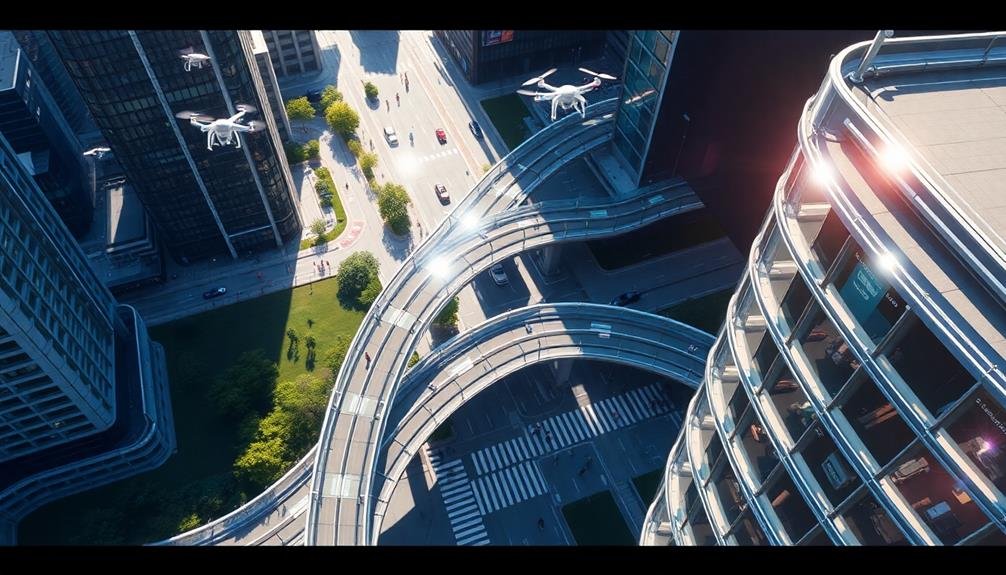



Leave a Reply